








Understanding Spring Terminology: Key Terms to Know Before Buying Springs
ENTER YOUR DIMENSIONS
Select Your Spring Type
COMPRESSION
EXTENSION
TORSION
Select Your Unit of Measurement
Warning Messages
Table of Content
How to Demystify Springs?
Think about it—springs are everywhere, from the click of your pen to the suspension system of the Mars Rover. But when you're faced with terms like "spring rate" or "free length," it’s easy to feel lost. That's where this guide comes in. We’ve put together a comprehensive glossary that breaks down the jargon into easy-to-understand language. Our goal is to make you feel more comfortable and informed when selecting springs, so you know exactly what you’re getting and how it’s going to perform.
Not only will you get to know the essential terms, but you’ll also learn about the different types of springs, their properties, and the tools that can help you design and test them. Whether you're designing a new product, replacing a worn-out part, or just curious about how springs work, this glossary is here to help.
And don't worry—this isn't just for the pros. We've made sure to keep things clear and approachable, so even if you're new to the world of springs, you'll be able to follow along. Plus, we’ll introduce you to some cutting-edge tools from Acxess Spring, like 3D CAD models, 3D Blueprints, and the Online Spring Force Tester (OSFT), that can take your understanding and design capabilities to the next level.
So, let’s dive in and start demystifying the world of springs! By the end of this guide, you’ll be equipped with the knowledge you need to make smart, informed decisions—whether you're shopping for springs or designing your own.
1. Basic Spring Terminology
To make things easier to grasp, let's break down some key spring terminology using a specific spring as our example: part number AC0625-750-12000-MW-3000-C-N-IN. This will help you see how these terms apply in the real world.
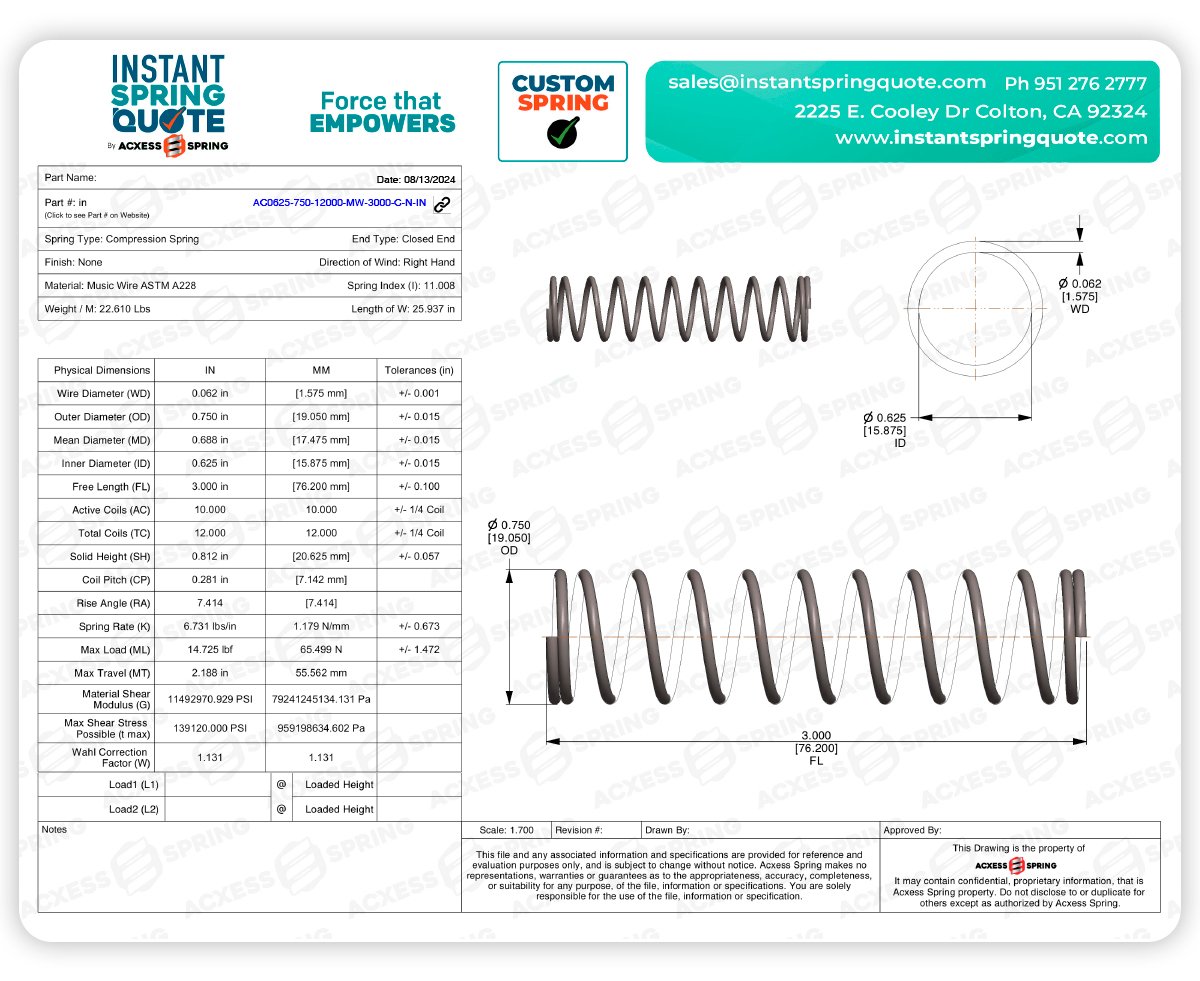
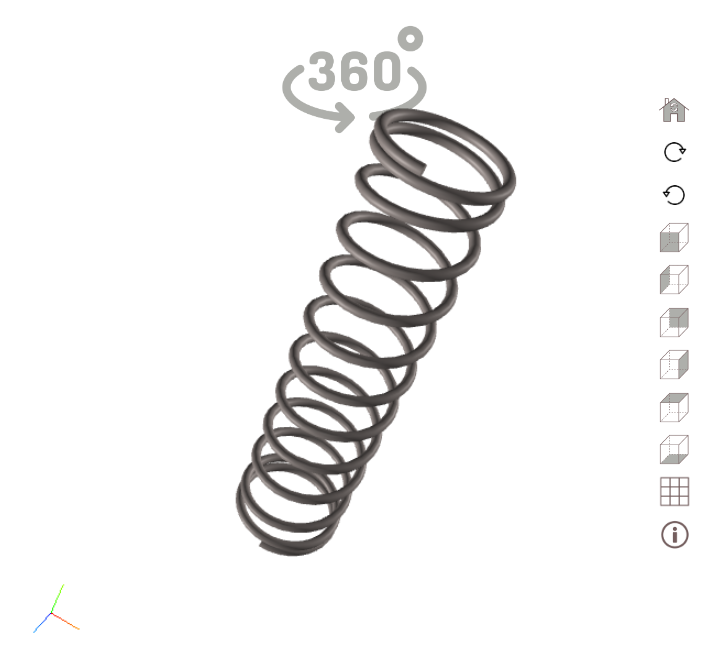
Wire Diameter (WD)

Wire diameter is the thickness of the wire from which the spring is made, measured in inches. This dimension directly impacts the spring's strength, stiffness, and load-bearing capacity. A spring made with a thicker wire diameter will be stiffer and capable of handling heavier loads than one made with a thinner wire. Our spring, with part number AC0625-750-12000-MW-3000-C-N-IN, has a wire diameter of 0.0625 inches.
Outer Diameter (OD)
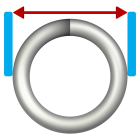
The outer diameter is the overall width of the spring, measured from the outer edge of one coil to the outer edge of the opposite coil. This measurement is essential for determining the spring’s fit within an assembly or housing. Our spring with an outside diameter of 0.750 inches, for example, should fit within a cavity slightly larger than 0.75 inches to ensure proper function.
Inner Diameter (ID)
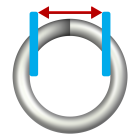
The inner diameter is the width of the open space within the spring, measured from the inner edge of one coil to the inner edge of the opposite coil. This dimension is important when a spring needs to fit over a rod or within a particular space. For example, our spring with an inside diameter of 0.625 inches will fit snugly over a rod with a slightly smaller diameter.
Free Length (FL)
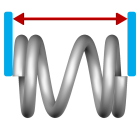
The free length of a spring is its overall length when it is not under any load. It is an essential dimension that helps determine the spring’s potential travel and the space it will occupy in an application. For example, if our compression spring has a free length of 3.000 inches and a solid height of 0.812 inch, it can compress by over 2 inches before becoming fully compressed.
Solid Height (SH)
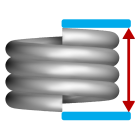
Solid height is the height of a compression spring when all its coils are fully compressed and touching one another. This measurement is critical because it represents the minimum length a spring can reach when under maximum load. Knowing the solid height helps prevent over-compression, which could lead to permanent deformation or failure of the spring. The solid height of our example spring has a solid height of 0.812 inches.
Total Coils (TC)

Total coils refer to the complete number of coils in a spring, including both active and inactive coils. This count is important for calculating various spring properties such as spring rate, free length, and maximum deflection. For example, our spring with 12 total coils will have 10 active coils (which contribute to the spring’s flexibility) and 2 inactive coils that are used for mounting or ensuring the spring ends are flat and parallel.
Active Coils (AC)

10 Active coils are the working coils of this spring that deform under load and contribute to the spring’s ability to store and release energy. In a compression spring, active coils are all those that are not in contact with each other when the spring is in its unloaded state. The number of active coils directly affects the spring's rate (stiffness) and its overall deflection capabilities. More active coils generally mean a lower spring rate, resulting in a softer spring.
Material Type
The material type of a spring plays a crucial role in determining its strength, durability, and suitability for specific applications. Common spring materials include:
-
Music Wire ASTM A228: Known for its high tensile strength and resistance to fatigue, often used in high-stress applications. The spring in our example is made out of Music Wire.
-
Stainless Steel ASTM A313:: Offers excellent corrosion resistance, making it ideal for applications exposed to moisture or chemicals.
-
Chrome Silicon ASTM A401:: Used in high-temperature environments and heavy-duty applications due to its superior heat resistance.
-
Phosphor Bronze: Provides good corrosion resistance and electrical conductivity, often used in electrical components. Choosing the right material depends on the environmental conditions and the specific requirements of your application.
End Type
End types refer to the configuration of the ends of a spring, which can significantly affect how the spring is mounted and how it performs. Common end types include:
-
Closed and Ground (CG): The last coil is bent back to touch the previous coil and ground flat, providing a stable base and even load distribution. The spring in our example has Closed and Ground ends.
-
Closed and Squared (C): Similar to closed and ground, but the end is not ground flat. This is less costly, The spring in our example has Closed and Squared.
-
Open Ends (O): The end coil is left open, which is useful in deriving all the compression springs travel deflection with a minimal solid height.
Wind Direction
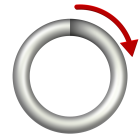
Wind direction describes the direction in which the coils of a spring are wound. Springs can be wound either right-hand or left-hand. The wind direction is crucial in applications where the spring is interacting with other components that have specific rotational forces, such as in torsion springs or in assemblies where multiple springs are used together. Matching the wind direction with the application requirements ensures that the spring operates correctly and safely. Our spring, for example, has a Right Hand (RH) wind direction.
Spring Rate

The spring rate, often referred to as the stiffness or spring constant, is the amount of force required to compress or extend a spring by a certain amount, typically one inch. Expressed in pounds per inch (lbs/in), the spring rate is a crucial factor in determining how the spring behaves under load. A higher spring rate indicates a stiffer spring that requires more force to compress or extend. Our example spring has a spring rate of 6.731 lbs/in.
Load
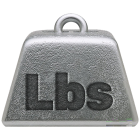
Load refers to the external force applied to a spring, causing it to compress, or extend. This force is measured in pounds (lbs) and is a fundamental factor in spring design and application. Understanding the load is essential for ensuring that the spring can handle the forces it will be subjected to without failure. Our spring, for example, has a maximum load of 14.725 lbs which means it won’t be able to handle over 15.2 lbs without failure.
Travel (Deflection)
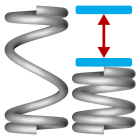
Travel, also known as deflection, refers to the distance a spring compresses or extends under a load. It’s the movement that occurs from the spring's free length compressing down to a loaded height for compression springs or to its maximum extension for extension springs. For example, if a compression spring has a free length of 3 inches and compresses to 1 inch under load, its travel, or deflection, is 1 inch. Understanding travel is crucial because it helps you determine how much movement in distance a spring needs within its application without going past the maximum travel which will overstress or damage the spring.
Maximum Travel (Deflection)

Maximum deflection is the greatest amount of distance a spring can be compressed for compression springs or extended for extension springs before it reaches its elastic limit. Exceeding the maximum deflection for our spring would be going past 2.1810 inches, and can lead to overstressing the spring, causing it to take a set and not return to its original length or deform permanently or possibly break.
Pitch
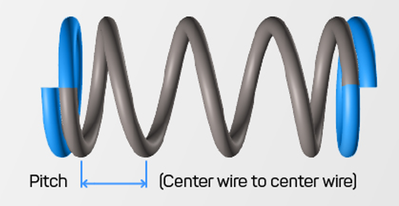
Pitch is the distance between the centers of adjacent coils in a spring. This distance affects the spring rate and the overall length of the spring when compressed. A larger pitch results in more space in between the coils and a longer free length if no coils are taken out, while a smaller pitch means less distance between adjacent coils and a shorter free length if no coils are taken out. Our example spring has 0.281 inches of coil pitch.
Spring Index
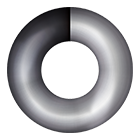
The spring index is the ratio of the mean coil diameter to the wire diameter. This ratio gives an indication of the spring’s tightness or looseness, affecting its manufacturability and performance. A low spring index indicates a tight coil that may be more challenging to manufacture, while a high index indicates a looser coil and is difficult to manufacture as well. Our example spring has a spring index of 10.905 which means it’s on the best manufacturing range at a low cost.
Initial Tension
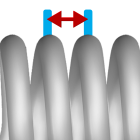
Initial tension is the force that keeps an extension spring in its closed-coil position without any external load applied. It is the built-in resistance that is sandwiched in between the springs coils that must be overcome before the spring begins to extend. For example, if an extension spring has an initial tension of 10 lbs, any force below this value will not cause the spring to extend or show light in between its coils.
Hooks Type
Hooks type refers to the configuration of the ends of an extension spring. The hooks are the loops or ends formed on the spring, allowing it to be attached to other components. Different hook types serve various purposes and can affect how the spring is used in an application. Common hooks types include:
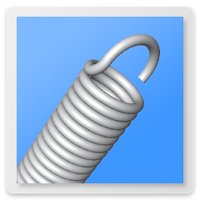
-
Machine Hooks: Standard hooks that are bent back over the body of the spring, commonly used for general applications.
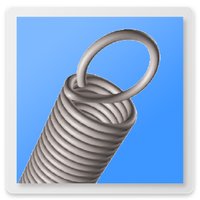
-
Crossover Hooks: These hooks cross over the spring’s body, offering a more compact design.
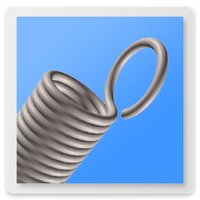
-
Side Hooks: Positioned on the side of the spring for specific attachment needs. Choosing the right hook type ensures the spring fits the application correctly and functions as intended.
Hook Length
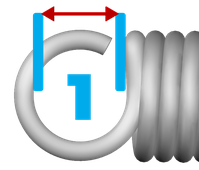
Hook length is the measurement of the length of the hook or loop from where it starts at the spring body to its end point on the inner diameter. This dimension is important for determining how the spring will fit and interact with other components in an assembly. A longer hook length may provide more flexibility in how the spring can be attached, while a shorter hook length may be necessary for tight spaces or specific mechanical requirements. The length of the hooks can also impact the overall length of the spring when it is in use, so it’s important to consider this measurement when selecting or designing a spring.
Free Position
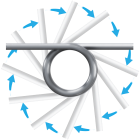
Free position refers to the natural, unloaded angular leg position of a torsion spring when no external forces are applied. It’s the angle or orientation of the spring's legs when the spring is at rest. This position is important because it represents the starting point from which any rotational deflection (twisting) will occur. Knowing the free position is crucial for ensuring that the spring is correctly oriented and will perform as expected in its application, especially in mechanisms where the spring’s position affects the function of other components.
Leg Length
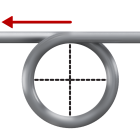
Leg length is the measurement of the straight sections of a torsion spring that extend from the coiled body to the centerline of the torsion spring. These legs are used to attach the spring to other parts of the mechanism and apply torque. The leg length can vary depending on the application, with shorter legs providing a more compact spring and longer legs allowing for more attachment options or specific torque characteristics. The leg length also plays a role in determining the overall space the spring will occupy within an assembly, so it’s important to choose the correct length based on the application’s requirements.
Stress
Stress in a spring refers to the internal forces per unit area within the spring material that result from an external load. It is typically measured in inch pounds per degree, in-lbs/degree. Stress levels must be carefully managed to ensure the spring operates within safe limits without risk of deformation or failure.
Set
Set refers to the permanent deformation a spring undergoes after being compressed, extended or twisted beyond its elastic limit. Once a spring takes a set, it will not return to its original length and can become deformed or break, which can affect its ability to perform as expected. Springs taking a set can occur if a spring is compressed, extended or twisted too far past their maximum travel distance leading to reduced performance and potential failure.
Load Point
A load point refers to a specific location on a spring where the load is applied like an L1 load point meaning it's the first load point. It’s important to consider the load point to ensure that the spring is loaded correctly and performs as expected. Incorrect loading can lead to uneven stress distribution and potential failure of the spring.
Spring Back
Spring back is the tendency of a material to return to its original shape after being compressed or extended. This characteristic is critical in applications where precise dimensions and shapes are necessary after forming or loading. For example, after a spring is compressed, it should spring back to its free length without permanent deformation.
2. Types of Springs
Compression Spring
A compression spring is designed to resist compressive forces and return to its original length when the force is removed. These springs are widely used in applications like automotive suspensions, ballpoint pens, and industrial machinery. The spring's load-carrying capacity, deflection, and spring rate are key considerations in its design and application.
Torsion Spring
A torsion spring is designed to operate with a rotational or twisting force, known as torque. The spring exerts a force proportional to the amount it is twisted. These springs are commonly found in applications such as garage doors, where they help counterbalance the door’s weight, and in various mechanical devices requiring a rotational force.
Extension Spring
An extension spring is designed to absorb and store energy as it is pulled apart. When the pulling force is removed, the spring returns to its original length. These springs are used in various applications, such as trampolines, screen doors, and mechanical devices that require a pulling force.
Conical Spring
A conical spring, also known as a tapered spring, has coils that decrease in diameter from one end to the other. This design allows for a more uniform spring rate and the ability to compress to a very short height, making them ideal for applications where space is limited. They are commonly used in electrical contacts and other applications requiring compact spring designs.
Helical Spring
A helical spring is the most common type of spring, made from wire coiled into a helical shape. It can be designed for compression, extension, or torsion applications, depending on how the ends are configured and how the spring is loaded. Helical springs are used in a wide range of industries and applications, from automotive components to everyday items like pens.
3. Material and Mechanical Properties
Shear Modulus
Shear modulus is a material property that measures the stiffness of a material in response to shear stress. It is an essential parameter for designing springs, especially torsion springs, as it determines how the material will react to twisting or rotational forces. A higher shear modulus indicates a stiffer material that will resist deformation under shear loads. Our spring, with part number AC0625-750-12000-MW-3000-C-N-IN, has a shear modulus of 11492970.929 psi.
Poisson’s Ratio
Poisson’s ratio is a material property that describes the ratio of lateral strain to axial strain in a material when it is subjected to compressive or tensile forces. It provides insight into how the material will behave under load, particularly in terms of its tendency to expand or contract laterally. This property is important when designing springs that need to maintain specific dimensional tolerances under load.
Fatigue
Fatigue refers to the progressive weakening of a spring due to repeated cycles of stress or loading. Over time, these repeated loads can cause the material to crack or fail. Understanding fatigue is crucial in applications where the spring will undergo many cycles of loading and unloading, such as in automotive suspensions or machinery that operates continuously.
Residual Stress
Rdsidual stress is the stress that remains in a spring after it has been manufactured and before any external load is applied. These stresses can arise from processes like coiling, bending, or heat treatment. Managing residual stress is important because it can affect the spring’s performance, longevity, and resistance to fatigue.
Heat Treatment
Heat treatment is a process used to enhance the mechanical properties of a spring by heating it to a specific temperature and then cooling it under controlled conditions. This process can improve the strength, hardness, and durability of the spring material, making it more resistant to wear, fatigue, and environmental factors like corrosion.
Surface Treatment
Surface treatment refers to processes like coating, plating, or painting that are applied to the surface of a spring to improve its corrosion resistance, appearance, or wear resistance. Common surface treatments include zinc plating, which protects against rust, and powder coating, which provides a durable and attractive finish. Surface treatment is essential for springs that will be used in harsh environments or exposed to corrosive substances.
Damping
Admping is the process of reducing oscillations or vibrations in a spring system. This can be achieved through the use of materials or components that absorb energy. Damping is crucial in applications where excessive vibration could lead to noise, wear, or failure of components, such as in automotive suspensions or precision instruments.
Natural Frequency
Natural frequency is the frequency at which a spring system oscillates when disturbed. Understanding the natural frequency is important to avoid resonant conditions, where external vibrations match the system’s natural frequency, leading to excessive oscillations or failure. In many applications, damping is used to control or alter the natural frequency to ensure stable operation.
4. Testing and Design Tools
Online Spring Force Tester (OSFT)
The Online Spring Force Tester (OSFT) is a tool that allows users to measure the force exerted by a spring at various lengths or deflections. This tool is invaluable for testing and verifying the performance of springs in real-world conditions, ensuring they meet the required specifications. The OSFT is particularly useful for engineers and designers who need to confirm that their spring designs will perform as expected under different loads.
3D CAD
3D CAD (Computer-Aided Design) is a digital tool that allows designers to create precise, three-dimensional models of springs and other components. This technology is essential for visualizing how a spring will fit and function within an assembly, enabling adjustments and optimizations before physical prototypes are made. Using 3D CAD, designers can experiment with different spring configurations, materials, and dimensions to achieve the desired performance.
3D Blueprints
3D Blueprints provide a detailed visual representation of a spring design, including dimensions, materials, and other specifications. These blueprints serve as a guide for the manufacturing process, ensuring that the final product meets all design criteria. 3D Blueprints are also valuable for communicating design details to clients, manufacturers, and other stakeholders involved in the production process.
5. Specialized Terms
Buckling
Buckling occurs when a compression spring bends or twists off its axis under load. This can happen if the spring is too long in relation to its diameter or if it is subjected to uneven loading. Buckling can lead to a loss of functionality or failure of the spring, making it essential to design and install springs properly to prevent this issue.
Surface Treatment
Surface treatment is a broad term that covers various processes applied to the surface of a spring to enhance its performance, appearance, and durability. These treatments can include galvanizing, electroplating, powder coating, and passivation, among others. The choice of surface treatment depends on the application and environmental conditions in which the spring will be used.
Master Spring Terminology and Make Confident Purchases Today!
Understanding the terminology associated with springs is essential for making informed decisions when selecting the right spring for your application. With this glossary, you should feel more confident navigating the various specifications and options available in the market.
Acxess Spring offers a range of tools like 3D CAD models, 3D Blueprints, and the Online Spring Force Tester (OSFT) to assist you in testing and verifying your spring designs. These resources can help you push the boundaries of innovation, ensuring that your springs meet the highest standards of performance and reliability.
By familiarizing yourself with these terms and leveraging the available tools, you can enhance your purchasing experience and ensure that you are selecting the most suitable spring for your needs. Whether you're designing a new product, replacing a worn-out component, or experimenting with different materials and configurations, this glossary will serve as a valuable reference in your journey.
- How to Demystify Springs?
- 1. Basic Spring Terminology
- Wire Diameter (WD)
- Outer Diameter (OD)
- Inner Diameter (ID)
- Free Length (FL)
- Solid Height (SH)
- Total Coils (TC)
- Active Coils (AC)
- Material Type
- End Type
- Wind Direction
- Spring Rate
- Load
- Travel (Deflection)
- Maximum Travel (Deflection)
- Pitch
- Spring Index
- Initial Tension
- Hooks Type
- Hook Length
- Free Position
- Leg Length
- Stress
- Set
- 2. Types of Springs
- 3. Material and Mechanical Properties
- 4. Testing and Design Tools
- 5. Specialized Terms
